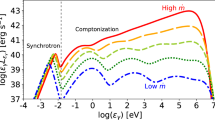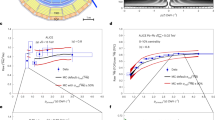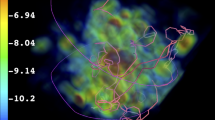Abstract
IN cosmological models where matter and antimatter occur symmetrically in the Universe1–5, their annihilation is likely to take place also at the present time. At the annihilation of a proton and an antiproton, ∼ 1.6 negative electrons and an equal number of positrons, each with an energy of ∼ 10–100 MeV are produced (Fig. 1), together with γ rays and neutrinos6. The initial electron energies can be expected to decrease gradually because of their interaction with cosmic magnetic fields, plasmas, and electromagnetic radiation. As a result of these interactions synchrotron radiation, bremsstrahlung, and inverse Compton radiation are all emitted. When optical photons are scattered against the relativistic electrons, X rays are produced by the inverse Compton effect. This mechanism may be an important source of cosmic X rays. Our purpose here is to study how efficient this X-ray mechanism can be in intergalactic space (where most of the annihilation electrons are expected to be found) and to see whether it can offer an explanation to the cosmic X-ray background observed (see refs 7–9).
This is a preview of subscription content, access via your institution
Access options
Subscribe to this journal
Receive 51 print issues and online access
$199.00 per year
only $3.90 per issue
Buy this article
- Purchase on Springer Link
- Instant access to full article PDF
Prices may be subject to local taxes which are calculated during checkout
Similar content being viewed by others
References
Klein, O., Mém. Soc. Sci. Liège, Quatrième Serie, XIII, 42–51 (1953).
Klein, O., Nature, 211, 1337–1341 (1966).
Alfvén, H., and Klein, O., Arkiv för Fysik, 23, 187–194 (1963).
Alfvén, H., Rev. Mod. Phys., 37, 652–665 (1965).
Omnès, R. L., Phys. Rev. Lett., 23, 38–40 (1969).
Ekspong, A. G., Yamadagni, N. K., Bonnevier, B., Phys. Rev. Lett., 16, 664–667 (1966).
Kasturirangan, K., and Rao, U. R., Astrophys. Space Sci., 15, 161–166 (1972).
Adams, D. J., and Ricketts, M. J., Astrophys. Space Sci., 24, 585–592 (1973).
Schwartz, D. A., in Int. Conf. X-Rays in Space, Calgary, Alberta, August 14–21, 1974, 1096–1119.
Allen, C. W., Astrophysical Quantities, 3rd ed., 289 (1973).
Korchak, A. A., Soviet Astr., 11, 258–263 (1967).
Turtle, A. J., Pugh, J. F., Kenderdine, S., and Pauliny-Toth, I. I. K., Mon. Not. R. astr. Soc., 124, 297–312 (1962).
Smith, F. G., Mon. Not. R. astr. Soc., 131, 145–153 (1965).
Gould, R. J., and Schréder, G. P., Phys. Rev., 155, 1408–1411 (1967).
Alfvén, H., and Elvius, A., Science, 164, 911–917 (1969).
Elvius, A., IAU Symp., No. 44, 306–310 (1972).
Elvius, A., Karlson, E. T., and Laurent, B. E., IAU Symp., No. 63, 341–345 (1974).
Author information
Authors and Affiliations
Rights and permissions
About this article
Cite this article
CARLQVIST, P., LAURENT, B. Annihilation of matter and antimatter and the cosmic X-ray background. Nature 260, 225–226 (1976). https://doi.org/10.1038/260225a0
Received:
Accepted:
Issue Date:
DOI: https://doi.org/10.1038/260225a0
This article is cited by
-
Oscillations in the primeval ambiplasma in the Universe
Astrophysics and Space Science (1985)
-
Size of ambiplasma domains in the Universe
Astrophysics and Space Science (1984)
-
Hubble expansion in a euclidean framework
Astrophysics and Space Science (1979)
-
Annihilation model of quasi-stellar objects
Astrophysics and Space Science (1979)
-
The cosmic X-ray background
Nature (1976)
Comments
By submitting a comment you agree to abide by our Terms and Community Guidelines. If you find something abusive or that does not comply with our terms or guidelines please flag it as inappropriate.



